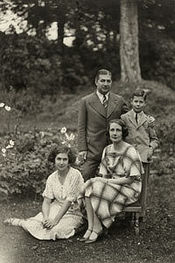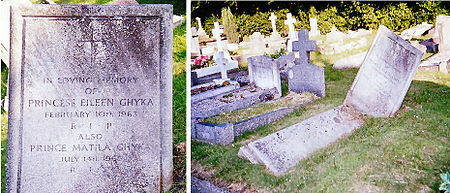- Matila Ghyka
-
Matila Ghyka 
Born September 13, 1881
Iaşi, RomaniaDied July 14, 1965 (aged 83)
London, United KingdomOccupation Naval Officer, Diplomat, Writer, Mathematician, Aesthetician, Historian Spouse Eileen O’Conor Children Maureen Ghyka (1920 – 1979)
Roderick Ghyka (1923 – 1978).Parents Matila Costiescu,< (father)
(mother)
Maria GhykaPrince Matila Costiesco Ghyka (born Matila Costiescu), K.C.V.O., M.C. (September 13, 1881 – July 14, 1965), was a novelist, mathematician, historian, philosopher and diplomat at the Romanian Plenipotentiary Minister in the United Kingdom during the late 1930s and until 1940. His first name is sometimes written as Matyla.
Life
He was born in Iaşi, the former capital of Moldavia, of the Ghica family of boyars. On his mother's side he was the great-grandson of Grigore Alexandru Ghica, last reigning Prince of Moldavia before the union of the Danubian Principalities.[1][2]
He first studied at the Jesuit Maritime College of Jersey (where he passed his matriculation when only 14), then at the French Naval Academy in Brest, at the High School of Electricity in Paris, and finally at the Faculty of Law of Université Libre de Bruxelles, where he took his doctorate magna cum laude. He joined the diplomatic service in 1910, being stationed at the Romanian Legations in Rome, Berlin, London, Madrid, Paris, Vienna, Stockholm (as Minister Plenipotentiary) and twice again in London between 1936-1938 and between 1939 and 1940. [3]
In 1918, at the Brompton Oratory, he married Eileen O'Conor (b. 1897, Sankt Petersburg), daughter of the late Sir Nicholas Roderick O'Conor (d. 1908), the former British Ambassador to Istanbul and Saint Petersburg, and Minna Margaret Hope-Scott. During his first diplomatic assignments in London and Paris, Prince Ghyka was introduced by Paul Morand and Prince Antoine Bibesco to the English and French literary circles. He became a friend of Marcel Proust and a "piéton de Paris" with the poet Léon-Paul Fargue. A frequent visitor of Natalie Clifford Barney's literary salon, he also met most of the American "exiled" writers of the 1920s, but his chief interest was always the synthesis of high mathematics and poetry. [3]
After World War II, Ghyka fled Communist Romania, and was visiting professor of aesthetics in the United States, at the University of Southern California and at the Mary Washington College, Virginia. An unassuming scholar, he took a mild interest in politics. His memoirs, which were published in 1961 under the title The World Mine Oyster, concluded with a confident message on the indestructibility of humanism. [3][4]
Prince Ghyka died in London and was survived by his son, Prince Roderick Ghyka, and daughter, Princess Maureen Ghyka. He was predeceased by his wife Eileen on February 10, 1963. Both Prince Matyla and Princess Eileen are buried in Gunnersbury Cemetery in London.[5]
Works
- Esthétique des proportions dans la nature et dans les arts (1927) (printed in Italian, Russian, Spanish)
- Le nombre d'or. Rites et rythmes pythagoriciens dans le development de la civilisation occidentale (1931) which ran into many editions and was prefaced by his friend and admirer Paul Valéry (translated into Italian, Czech, Spanish, Polish)
- Pluie d'etoiles (1933) (English as Again One Day, 1936) - the only novel Ghyka wrote, printed in roumanian
- Essai sur le rythme (1938)
- Tour d'horizon philosophique (1946)
- Sortileges du verbe (1949), prefaced by Leon-Paul Fargue
- A Documented Chronology of Roumanian History from Pre-historic Times to the Present Day (1941), printed in roumanian
- The Geometry of Art and Life (1946)
- Tour d'horizon philosophique (1946)
- A Practical Handbook of Geometry and Design (1952)
- Philosophie et Mystique du nombre (1952) (translated into Serbian, Spanish, Roumanian)
- Couleur du monde (1: Escales de ma jeunesse,1955, 2: Heureux qui comme Ulysse, 1956)" (translated into roumanian)
- The World Mine Oyster. London, Heinemann, 1961 (English version of "Couleur du monde")
References
Categories:- Ghica family
- Romanian diplomats
- Romanian essayists
- Romanian historians
- Romanian mathematicians
- Romanian novelists
- Romanian poets
- Romanian writers in French
- Knights Commander of the Royal Victorian Order
- Free University of Brussels alumni
- People from Iaşi
- 1881 births
- 1965 deaths
- University of Mary Washington faculty
Wikimedia Foundation. 2010.


